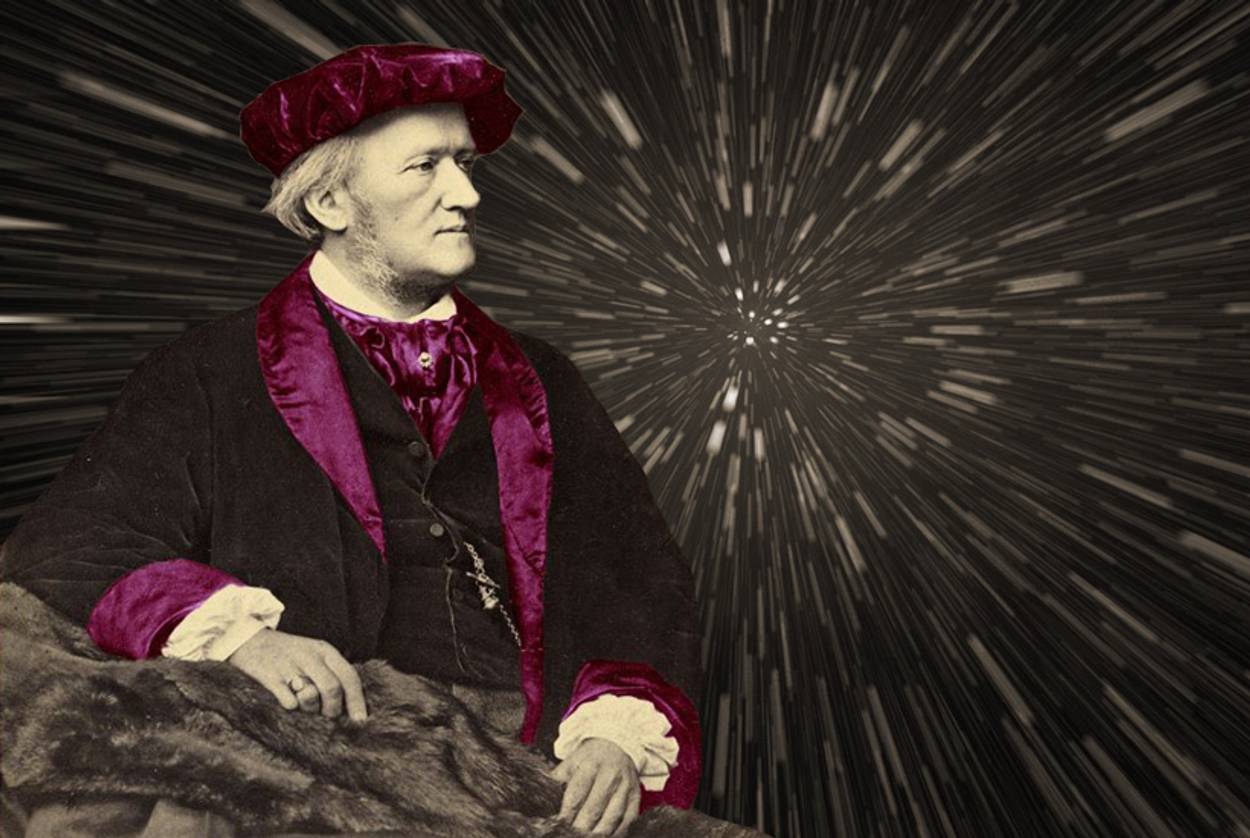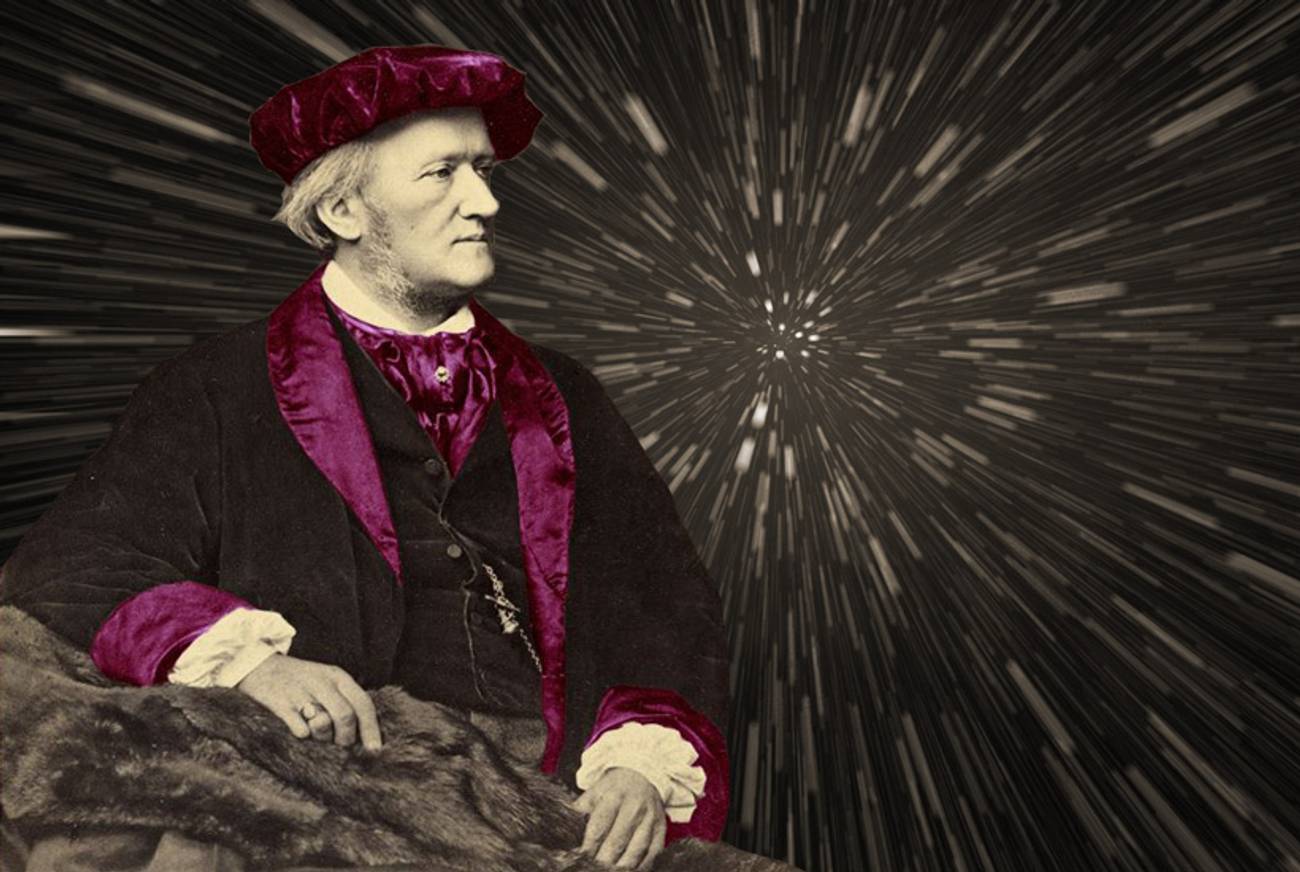Did Richard Wagner Inspire Hitler or Did He Inspire ‘Star Wars’? And Does It Matter?
The whole question of modernity, in new assessments of the German composer and his work




While Wagnerian fanatics undeniably include a contingent of what one critic memorably referred to as “leathery old Nazis,” these are now no longer taken seriously. After a period of intense academic/historical skirmishing in the late 1980s to mid-1990s, recent advancements in Wagner studies scholarship have settled our understanding of the genealogical sources of his ideas. His anti-Judaism belonged to the Utopian, anti-clerical family of the sort held by Marx and Bauer as well as drawing on the race theorists and social Darwinism circulating at the time: His overriding obsession with purity of German myth and language metastasized easily into a crusade for purity of race. Adorno’s once crankish position that Wagner’s work was the decisive element linking the 19th-century rebirth of German Romanticism to the development of National Socialism now approximates something akin to received wisdom. Hitler’s love for the work, epitomized by his identification with the character of the sensitive misunderstood (and eventually victorious) artist Walther von Stolzing in Die Meistersinger von Nürnberg (The Mastersingers From Nuremberg) is a fait accompli matter in the opera’s patrimony and will most likely forever encrust the works with a grimy layer of infamy.
Given that Wagner’s music has clearly stood the test of time, what remains is a host of delicate and unresolved questions about the implications of the composer’s anti-Semitism and other toxic affinities: Was Wagner merely acting as a vessel for commonly accepted ideas? Are the anti-Semitic tropes interwoven into the formal properties of the music and operas themselves? If music, as Wagner’s defenders often proclaim, cannot be fascist, what about the contents of the librettos? If the librettos are indeed not anti-Semitic, does that justify the lifting of Israel’s unofficial ban on reciting his works? Writing in the New York Review of Books last summer, the conductor Daniel Barenboim, perhaps the most ardent living champion of Wagner’s rehabilitation, began his eloquent vindication of the right to play Wagner in Israel with the observation that “perhaps no other composer in history sought to combine such obviously incompatible elements in his works.”
A new exhibition Euphoria and Unease: Jewish Vienna and Richard Wagner up through March 16 at the Jewish Museum of Vienna, and a newly translated biography Richard Wagner: A Life in Music, by German musicologist Martin Geck, both attempt to give new answers to these oft-asked questions. Both are sketchily ethereal and less stridently judgmental about Wagner’s proto-Nazism than has recently been the case, perhaps auguring a new trend toward post-ideological enjoyment of the composer’s work. Yet there remains no definitive consensus on what drove Wagner to become an anti-Semite in the first place.
***
The definitive scholarly examination for a general reader of Wagner’s anti-Semitism remains Jacob Katz’s1986 monograph The Darker Side of Genius, which ably enumerates the conventional narrative of how Wagner developed his ideas about and violent hatred of the Jews. The classical explanation lies in Wagner’s deep resentment at the public success and facile genius of his two Jewish contemporaries in the German musical world: Felix Mendelssohn and Giacomo Meyerbeer. That Mendelssohn was the wealthy and cosseted son of a banker, while Wagner grew up in the shadow of poverty and illegitimacy did not help matters either. At 18 Wagner sent his only handwritten manuscript of an early symphony to Mendelssohn. It was promptly lost in the mail—an accident that he probably blamed on the Jews. Despite his mixed feelings, Wagner only retroactively filtered his resentments through the lens of his rivals’ Jewishness. He did so in his infamous 1850 essay “Das Judenthum in der Musik” (On Jewishness in Music), which was written under a pseudonym (tellingly it did not appear until after Mendehlson’s sudden death in 1847) and that he had republished under his own name two decades later.
A humiliating and unproductive sojourn Wagner took in Paris during his mid 20s didn’t help much, either. Having fled his conductor’s appointment at the court of Riga through the Russian border to avoid the clutches of his creditors (some of whom, yes, were Jewish), Wagner arrived in Paris with great hopes, but the French reaction to his work was dismissively cool. Wagner’s only income in Paris came from the German Jewish music publisher Maurice Schlesinger, who commissioned him to correct musical proofs. Wager bristled at the work, which was mostly of transcribing and collating the work of the now somewhat obscure French Jewish composer Fromental Halévy. The cloying sycophancy of the young Wagner’s letters to both Schlesinger and Meyerbeer make for uncomfortable reading, and the composer’s resentment must have congealed into rancor after Meyerbeer rebuffed him.
Decamping from Paris he returned to Germany to witness the first stirring of the revolutions of 1848 and was promptly banished from Dresden for his part in that city’s failed uprising. His enthusiasm for Utopian politics of redemption curdled into a romantic fantasia of escape from worldly corruption into a resurgent mythopoetic dreamworld that would regenerate a conservative society into belatedly accepting the poet-composer as its savior. Katz’s own conclusion is that Wagner simply took himself too seriously, that “his consciousness of his brilliant originality in music seems to have given him a sense of confidence in his own judgment, even in areas in which he had very little knowledge at his disposal.”
Wagner’s latest biographer, Geck, worked on the catalogue raisonné of Wagner’s works as well as the critical edition of Parsifal before writing A Life in Music. He faces the underlying problem of all of the dozens of Wagner biographers in trying to find the impossible balance between rehashing the events of Wagner’s fabulously picaresque life and laying out the intellectual history/ideological critique and musicology. Geck’s book falls squarely on the musicology corner of the intellectual-history/musicology axis. He is extremely perceptive in his explanation of the way Wagner used the echoes of Beethoven’s and Bach’s themes to synthesize an archaizing mood for his newly created genre of symphonic opera. Extremely spirited and fluid, the book nonetheless almost reaches a point of incomprehensibility to nonspecialists. (For a straight account of Wagner’s life, minus the semiotics and references to Heidegger and Julia Kristieva, the general reader should turn to Barry Millington’s Wagner: The Sorcerer of Bayreuth.)
Geck also mostly avoids the second problem of Wagner biographies, which is whether to rely on Cosima Wagner’s voluminous diaries and Wagner’s self-serving autobiography by opting for a dizzily erudite interpretive approach, making this perhaps the first postmodern Wagner biography. He more or less successfully defends Wagner’s characters from the charge of being simple, anti-Semitic stereotypes of the wheeling, cringing, degenerate Jew by invoking the complexity and ambivalence with which Wagner imbued all of his characters, in operas that are about the specter of violent redemption through love.
Geck’s excellent 2009 essay “What Was Eating Wagner?” makes clearer his allegiance to the “failed revolutionary” as the culprit for Wagner’s turn to the Dark Side. I hope to be forgiven the pun, as Wagner did inspire Star Wars, which conjured a world of dueling feudalistic moralities that personified one side as an expression of inherent evil. Geck both concentrates attention on and elides a direct confrontation with the ideological place of anti-Semitism in Wagner’s work by adding crisp, aphoristic “a word about” mini-chapters to the end of each of the book’s 13 chapters. Each “a word about” discusses Wagner’s relationship with or influence on a Jew, such as his self-loathing accompanist Josef Rubinstein.
The exhibition in the Vienna Jewish Museum exhibit showcases the expected Wagner collectibles, of which there are many, as Vienna housed some of the first, and most obsessive, Wagner societies. The show focuses understandably on his Vienna years and connections. Consequently and perhaps misleadingly, it focuses on minor quarrels and local characters in the Wagner saga. These include his wrangling with his Viennese seamstress Bertha Goldwag, and portraits of all-but-forgotten midcentury oddballs and racists such as Felix Mottl, Otto Weininger, Guido von List, or the pan-German radical Georg Ritter von Schonerer. Wagner’s relations toward Anton Bruckner can only be described as “snotty.”
The show also focuses on Wagner’s prickly relations with scornful contemporary music critics such as the Jewish critic Eduard Hanslick. Wagner blamed Hanslick for (what he wrongly perceived as) his lack of success, and after Hanslick got his hands on a trove of embarrassingly vain letters between Wagner and his seamstress, he published them with vindictive glee. The perennial problem faced by tempestuous personality types who collect enemies is in the risks of ascribing an essentialist group characteristic to one’s enemies. Typically, Wagner failed to take note of the fact that not every music critic is a Jew and that, conversely, not every Jew is a music critic.
What the exhibit does extremely well is inculcating the facts of the sheer number of Jewish musicians and conductors that were instrumental in revealing Wagner’s dark magic to the wider world as well as the ironic repercussions that dark magic wrought upon Viennese Jewry. (Mahler’s first production after leaving Vienna for New York was conducting Tristan and Isolde at the Metropolitan.) The Viennese musical world—the world of Mahler, Korngold, Arnold Schoenberg, Alexander von Zemlinsky—was decimated by the Anschluss. Reading the plaques and dates on the wall one cannot help but be shocked by how many Viennese Jews died in American exile.
As poised and thorough as the exhibit is, in another sense it is compromised by the adoption of an oddly over-solicitous tone—uncommitted to passing judgment on the master himself, his disciples, or anyone who appropriated his music for their own ideological ends. It also spares from rebuke the apolitical ordinary listeners who choose to revel in the primordial ecstasy of Wagner’s operas while ignoring the unpleasant implications of his cosmology. Indeed, the exhibit is free to refrain from taking a position on Wagner by a calculated recitation of the judgments of others. It concludes as this essay began, with a meditation of the Wagner ban in Israel, along with the presentation of dozens of epigrams about Wagner inscribed on the walls of the exhibit’s final room.
Depending on one’s sensibility, this culmination is either a curatorial sleight of hand or a daring, post-ideological invitation for debate. The quotes argue both the case for and the case against the rejection of the inherent putrescence of Wagner’s legacy. The opinions range from the flippant and exculpatory to the outraged and damning. Some are mournfully apologetic, such as Gottfried Wagner’s admission that the “ideology of Beyruth contributed to Hitler’s rabid madness and everything that ensued from it.” Several prominent Viennese critics and scholars protest both “right wing ideological” and “Israeli” appropriation of the music, demanding their right to enjoy it unmolested by the discomfort of complex emotions. We are reminded also of Woody Allen’s immortal crack from Manhattan Murder Mystery that “I can’t listen to that much Wagner. I start getting the urge to conquer Poland.” Finally there is the recently deceased French Opera director Patrice Chéreau’s simple declaration that “Wagner is not sacred.”
Yet curiously absent from that wall are any of the epigrams from “Nietzsche contra Wagner.” Looking at that wall there is one that I could not avoiding recalling. Nietzsche knew full well what he was talking about when he predicted that “one has almost calculated the whole of the value of modernity, once one is clear concerning what is good and evil in Wagner.”
***
Sign Up for special curated mailings of the best longform content from Tablet Magazine.
Vladislav Davidzon, the Chief Editor of The Odessa Review, is a Russian-American writer, translator, and critic. He was born in Tashkent, Uzbekistan, and lives in Paris.
Vladislav Davidzon is Tablet’s European culture correspondent and a Ukrainian-American writer, translator, and critic. He is the Chief Editor of The Odessa Review and a Non-Resident Fellow at the Atlantic Council. He was born in Tashkent, Uzbekistan, and lives in Paris.